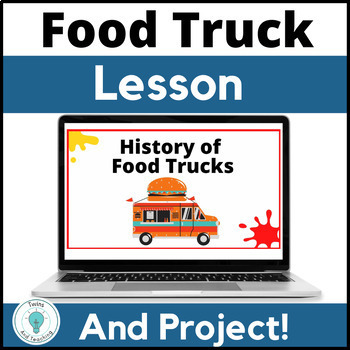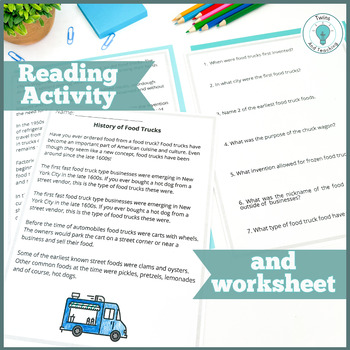Food Truck Template - Project and Lesson History of Food Trucks and Project
- Google Drive™ folder

What educators are saying
Also included in
- Price $210.98Original Price $321.40Save $110.42
- This mini-bundle of 18 culinary arts lessons and activities will save you so much time while keeping your students engaged and learning! Each culinary arts activity includes readings or presentations and questions to help your students learn important culinary basics including cooking techniques, kiPrice $48.25Original Price $70.50Save $22.25
- This high school and upper middle school CTE Culinary Arts lesson plan bundle of over 100 lessons and activities will have you planned for a semester or year-long course in Culinary Arts or a Family and Consumer Science foods course. Each lesson and activity is no-prep to you and is easily assignedPrice $390.25Original Price $583.15Save $192.90
- This growing bundle of materials for a family consumer science or FACS class includes culinary arts, child development, nutrition, and sewing. As we create new activities for these topics, they will be added at no extra cost. These engaging FCS lessons include:Culinary materials:bell ringer journalsPrice $158.50Original Price $231.75Save $73.25
Description
Are you teaching about food trucks and looking for a no-prep lesson and activity for your Culinary Arts and FACS students? This Google resource includes a 14-page presentation on the history of food trucks from the days of hot dog wheel carts in NYC to the popularity of food trucks today. Students learn about food trucks and then create their own!
This food truck project and activity is great for:
- family and consumer science
- culinary arts
- Prostart
- Home Economics
- food and nutrition
This food truck resource includes:
- A 14-slide presentation on the history of food trucks, and types of food trucks
- 3-page student worksheet about food trucks
- 7 questions for students to answer about the presentation on food trucks
- design your own food truck with a theme, entrees, appetizers, and design
- Printable food truck menu
- Food Truck project editable rubric
National Family and Consumer Science Standards:
8.1.2 Analyze opportunities for employment and entrepreneurial endeavors. *8.1.3 Summarize education and training requirements and opportunities for career paths in food production and services. 8.1.4 Analyze the effects of food
⭐ You May Also Like these Culinary Arts Resources:
Culinary Arts Bell Ringer Journal
Herbs and Spices Lesson and Activity
Agriculture and Food Production Lesson
⭐ Let’s Connect:
Email List for freebies and updates on new lessons
⭐ Get TPT credit to use on future purchases:
• Go to your My Purchases page (log in first). Click on the Provide Feedback button to leave a rating and a short comment. You’ll earn TPT credits, which you can redeem on future purchases!
Copyright ©twinsandteaching
All rights reserved by author
Permission to copy for single classroom use only









